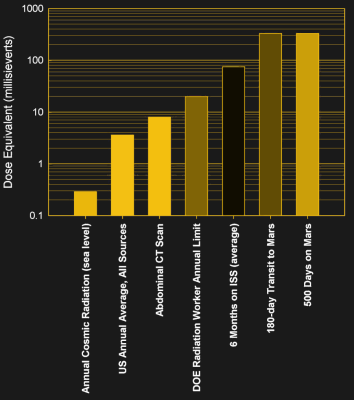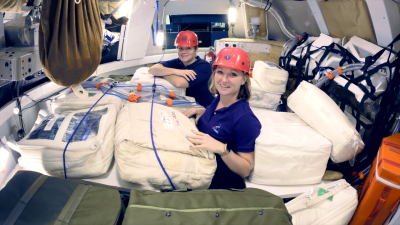Outer space is not exactly a friendly environment, which is why we go through great lengths before we boost people up there. Once you get a few hundred kilometers away from our beloved rocky planet things get uncomfortable due to the lack of oxygen, extreme cold, and high doses of radiation.
Especially the latter poses a great challenge for long-term space travel, and so people are working on various concepts to protect astronauts’ DNA from being smashed by cosmic rays. This has become ever more salient as NASA contemplates future manned missions to the Moon and Mars. So let’s learn more about the dangers posed by galactic cosmic rays and solar flares.
Radiation from Space
When German Jesuit priest and physicist Theodor Wulf climbed the Eiffel Tower in 1910 with an electrometer he wanted to show that natural sources of ionizing radiation are originating from the ground. And while readings on top of the tower were lower than the ground level, they were still much higher than would be expected if the ground were the only source. A few years later, Victor Hess undertook several risky balloon flights up to altitudes of 5.3 km to systematically measure the radiation level by observing the discharge rate of an electroscope. His experiments showed that radiation levels increase above ~1 km, and he correctly concluded that there must be some source of radiation penetrating the atmosphere from outer space.
The cosmic rays that rain down on Earth are predominantly protons (~90%), helium nuclei (~9%), and electrons (~1%). In addition, there is a small fraction of heavier nuclei and a tiny whiff of antimatter. These particles are blasted to us from the Sun and other galactic and extragalactic natural particle accelerators like supernovae or black holes.
How Earth Keeps Us Safe

Credit: Marko Markovic, public domain
Luckily for us, the Earth’s magnetic field deflects many of the charged particles so that they never hit the atmosphere. Some of them are captured in two donut-shaped rings around the Earth, the Van Allen Belts. In addition, the atmosphere also does a good job of protecting us. Primary cosmic rays hitting the atoms in our atmosphere produce a shower of secondary particles with much lower energies so that most of them will not reach the ground.
The average radiation exposure here on Earth is about 3 mSv per year. Depending on your altitude, about 0.39 mSv (13%) is contributed by cosmic radiation. Flying in an airplane at 12 km altitude increases your radiation exposure about 10x compared to sea-level. Things are even worse if your flight route is near the geomagnetic poles where charged particles are concentrated. If you are interested in the radiation dose you will receive on your next flight, check out NASA’s NAIRAS webpage. It provides a global map of radiation dose rates for different altitudes that are produced in near real-time from measurements of solar activity and cosmic rays.
Doses on the ISS, the Moon, and Mars

Credit: ASA/JPL-Caltech/SwRI, Public Domain
For a crew member of the ISS, the average radiation dose is about 72 mSv for a six-month stay during solar maximum: it is about 50 times higher than on Earth. Because the contribution from solar particles varies with the 11-year solar cycle, one might think that the radiation dose is lower during solar minimum. But in fact, the dose is about twice as high as during solar maximum.
This is because the dominant source of radiation on the ISS is galactic cosmic rays (GCR), which are deflected by the Sun’s magnetic field. GCR intensity is highest during solar minimum when the Sun’s magnetic field is weakest. Even a big solar particle event (SPE) like a solar flare or coronal mass ejection cannot hurt ISS astronauts much but instead sweeps away other charged particles thereby reducing the GCR flux for weeks. This effect is known as the Forbush decrease.
Another big contribution to the radiation exposure aboard the ISS comes from protons trapped in the Van Allen belt. The exposure is largest when the ISS crosses the so-called South Atlantic Anomaly (SAA) where the radiation belt comes closer to Earth’s surface. Most of the time, the ISS orbits comfortably inside the Van Allen belt, but during the 5% of the mission time that the ISS is spends in the SAA, it can be responsible for more than 50% of the total absorbed radiation dose.
The Moon, on the other hand, is exposed to all kinds of cosmic rays since it is located much further away and has neither a magnetic field nor an atmosphere. Here SPEs like the big solar storm that occurred in August 1972, shortly in between the Apollo 16 and Apollo 17 lunar missions, can be life-threatening events for astronauts. Recently, the Lunar Lander Neutrons and Dosimetry (LND) experiment aboard China’s Chang’E 4 lander has measured the radiation exposure on the lunar surface. With about 500 mSv/year the radiation dose is nearly 200 times higher than on Earth.
Plans for manned missions to Mars are already underway and radiation exposure is one of the main concerns. Estimations of the radiation dose for a trip to Mars are based on measurements of the Radiation Assessment Detector (RAD) piggybacking on the Curiosity rover. During a 360-day round trip, an astronaut would receive a dose of about 660 mSv. Assuming that the crew would spend 18 months on the surface while they wait for the planets to realign, they will be exposed to an additional 330 mSv. So the total exposure for an astronaut going to Mars and back will be around 1,000 mSv. This is equal to the exposure limit for NASA astronauts during their entire career, and corresponds to a 5.5% risk of death due to radiation-induced cancer. Therefore, although there is certainly a severe health risk, radiation exposure is not a showstopper for a mission to Mars.
Protecting Space Travelers

Credit: NASA
Astronauts aboard the ISS are partially protected against radiation by the station’s aluminum hull. Materials with low atomic number provide the most effective protection against space radiation including secondary particles like neutrons. Such lightweight materials are also cheaper to bring into space. The ISS has equipped their crew quarters with polyethylene bricks that reduce the radiation dose by 20%.
If we ever construct settlements on the Moon, they will probably be buried beneath lunar soil to be shielded from SPEs and other cosmic rays. On the downside, this would also increase the exposure to secondary neutrons, as measurements of the Apollo 17 Lunar Neutron Probe Experiment have shown.
NASA’s Orion spacecraft is planning to bring people to the Moon in 2024 and eventually to Mars. Since the additional mass for dedicated shielding would simply be too expensive their radiation protection plans include the possibility to build a shelter from onboard supplies including food and water in case of an SPE.
Let’s not forget that space radiation is not only dangerous to humans but also to electronic equipment. High-energy particle interactions can easily damage critical electronic systems on a spacecraft and are causing total or partial mission loss for between one and two satellites per year. Extreme SPEs can even influence equipment on Earth like the 1972 solar storm which is said to have caused the accidental detonation of two dozen US sea mines in Vietnam.
For the future of space travel, more advanced active shielding concepts are the topic of ongoing research. These include powerful magnetic or electrostatic fields and plasma “bubbles” surrounding a spacecraft to deflect charged particles. Of course, radiation protection is only one of the many challenges posed by long-term space travel but let’s hope we will find ways to keep our astronauts safe and healthy.
No comments:
Post a Comment